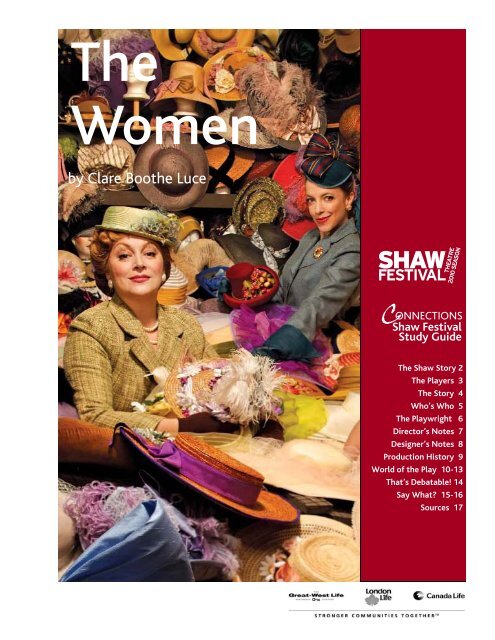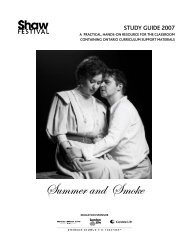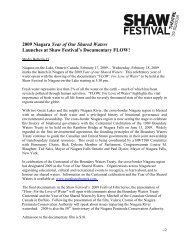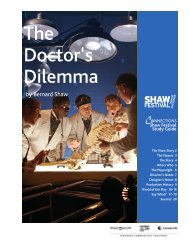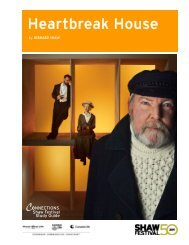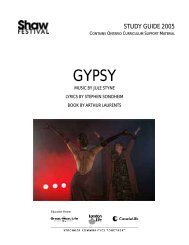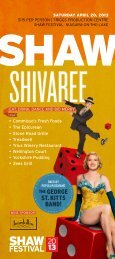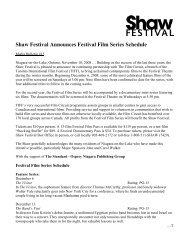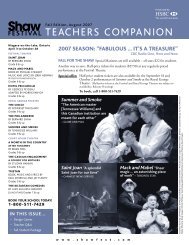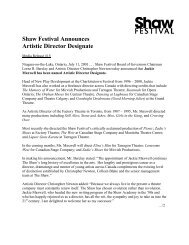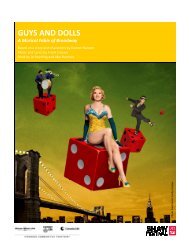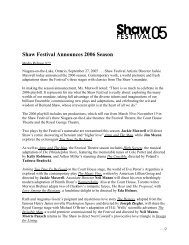The Women.pub - Shaw Festival Theatre
The Women.pub - Shaw Festival Theatre
The Women.pub - Shaw Festival Theatre
You also want an ePaper? Increase the reach of your titles
YUMPU automatically turns print PDFs into web optimized ePapers that Google loves.
<strong>The</strong><strong>Women</strong>by Clare Boothe LuceC<strong>Shaw</strong> ONNECTIONS<strong>Festival</strong>Study Guide<strong>The</strong> <strong>Shaw</strong> Story 2<strong>The</strong> Players 3<strong>The</strong> Story 4Who’s Who 5<strong>The</strong> Playwright 6Director’s Notes 7Designer’s Notes 8Production History 9World of the Play 10-13That’s Debatable! 14Say What? 15-16Sources 17
THE SHAW STORYMANDATE<strong>The</strong> <strong>Shaw</strong> <strong>Festival</strong> produces and presents the work of George Bernard <strong>Shaw</strong>(1856-1950) and playwrights writing anywhere in the world during, or about,the era of <strong>Shaw</strong>’s lifetime.WHAT MAKESSHAW SPECIAL<strong>Festival</strong> <strong>The</strong>atreCourt House <strong>The</strong>atreVALUES• <strong>The</strong> <strong>Shaw</strong> <strong>Festival</strong> chooses works for presentation that are challenging,provocative and intelligent.• Productions engage audiences with clever, insightful, and delightful portraitsof the human condition.• <strong>The</strong> works chosen often resonate with the wit, social commentary, andtopical relevance for which G.B. <strong>Shaw</strong> himself was well known.• <strong>The</strong> <strong>Shaw</strong> <strong>Festival</strong> is dedicated to excellence, consistency, and integrity in allits creative and administrative practices.• <strong>The</strong> <strong>Shaw</strong> <strong>Festival</strong> operates within a fiscally responsible and accountableframework.THE SHAW FESTIVAL ATTRIBUTES ITS SUCCESS TO:<strong>The</strong> Ensemble - their talent, continuity, generosity, and collegiality fuel all ofthe <strong>Festival</strong>’s efforts<strong>The</strong> Company - their singular sense of purpose fosters mutual trust, respect,and dedication to the <strong>Festival</strong><strong>The</strong> Repertory - the alternating schedule of performance serves the audienceand inspires the company<strong>The</strong> Mandate - 1856-1950 offers a wealth of material to fascinate and delight,liberating the ensemble to explore complex questions from the safety of thenot too distant past while encouraging audiences to re-discover themselvesthrough the lens of historical perspective<strong>The</strong> <strong>Shaw</strong> <strong>Festival</strong> is a crucible of progressive and provocative ideasinspired by the brilliance, bravery, humanity, and humour ofGeorge Bernard <strong>Shaw</strong>.OUR THEATRES<strong>The</strong> <strong>Shaw</strong> <strong>Festival</strong> presents plays in four distinctive theatres. <strong>The</strong> <strong>Festival</strong><strong>The</strong>atre with 869 seats is <strong>The</strong> <strong>Shaw</strong>’s flagship theatre; the historic Court Housewhere <strong>The</strong> <strong>Shaw</strong> first began performing seats 327; and the Royal George<strong>The</strong>atre, modeled after an Edwardian opera house, holds 328. Our new Studio<strong>The</strong>atre has flexible seating and can accommodate approximately 200 seats.THE SHAW’S COAT OF ARMSIn 1987, on the occasion of our 25th Anniversary, the <strong>Shaw</strong> <strong>Festival</strong>became the second theatre company in the world to be granted aCoat of Arms by the College of Heralds. A large painted sculpture ofour Coat of Arms adorns the lobby of the <strong>Festival</strong> <strong>The</strong>atre.Royal George <strong>The</strong>atre2CONNECTIONS<strong>Shaw</strong> <strong>Festival</strong> Study Guide
C ONNECTIONSStudy GuideA practical, hands-onresource for theclassroom whichcontains backgroundinformation for theplay, and suggestedthemes for discussion..Designed byeducators andtheatre professionals,the activities andthemes for discussionare organized inmodules that can beused independentlyor interdependentlyaccording to the classlevel and timeavailability.<strong>The</strong> <strong>Women</strong> isrecommended forstudents in grade 9and higher.This guide waswritten and compiledby Amanda Tripp.Additional materialswere provided byJoanna Falck, AlisaPalmer, and WilliamSchmuck.Cover: Deborah Hay,Laurie PatonPhoto by: Shin SuginoPreviews: May 12Opens: May 29Closes: October 9Sylvia FowlerNancy BlakePeggy DayEdith PotterMary HainesCountess de LageMiriam AaronLittle MaryMrs MoreheadCrystal AllenJane/PedicuristDirectorSet & Costume DesignerLighting DesignerComposerTHE PLAYERSDEBORAH HAYKELLI FOXBERYL BAINJENNY L WRIGHTJENNY YOUNGWENDY THATCHERNICOLA CORREIA-DAMUDECELESTE BRILLON/KATE WILSONSHARRY FLETTMOYA O’CONNELLMELANIE PHILLIPSONOlga/Fitter/Miss Trimmerback/First Society Woman…………………………... LISA CODRINGTONEuphie/Corset Model/ Helene/Second Girl in Powder Room……………….. JULIA COURSESecond Hairdresser/Negligee Model/Exercise Instructress/ Cigarettes ………….. SACCHA DENNISDebutante/Girl in Distress/Extra Pedicurist/Second Sales Girl………...IJEOMA EMESOWUMSecond Waleswoman/Maggie/Lucy/Dowager………………………………………PATTY JAMIESONHairdresser/Princess Tamara/Second Society Woman ………………………..HEATHER McGUIGANMiss Fordyce/ Head Saleswoman/Nurse/Sadie………………………………………… ..HELEN TAYLORExtra Hairdresser/First Sales Girl/Miss Watts/ First Girl in Powder Room…..JACQUELINE THAIRTHE ARTISTIC TEAMSYNOPSISALISA PALMERWILLIAM SCHMUCKKEVIN LAMOTTELESLEY BARBERWhen a Manhattan socialite finds out her husband is cheating, her friends are nohelp at all. With manicured claws, these women must fight to maintain their statuswhile scheming to leave, steal or win back their own husbands. Clever, cut-throat,and delicious, a satirical look into the lives of the ladies who lunch and the worldthat determines their behaviour.CONNECTIONS 3<strong>Shaw</strong> <strong>Festival</strong> Study Guide
“<strong>The</strong>women whoinspired thisplay deserved tobe smackedacross the headwith a meat axand that, Iflatter myself, isexactly what Ismacked them”with.‐ Clare Boothe Luceon <strong>The</strong> <strong>Women</strong>THE WOMEN“I don’t ask any man to understand me. How could he? I’m a woman.”As the title suggests the play is entirely populated by women — there is not a singleman in the 35 person cast. But playwright Clare Boothe Luce herself admitted in herintroduction to the play that <strong>The</strong> <strong>Women</strong> really focuses on a small and exclusivegroup, as she describes them, “a numerically small group of ladies native to the ParkAvenues of America”. And so the play opens a window into the world of women -not only do we meet these Park Avenue princesses, but we listen into theconversations of the hairdressers, manicurists, and saleswomen, all who share theirown lives and concerns.<strong>The</strong> play centres on Mary Haines — the ‘nice one’ in a group of Manhattan friends. Inthe opening scene, the ladies play bridge and complain, mostly about men. Marybecomes the object of fun because of her happiness, her seeming contentment withmarriage and her husband. Because these are all women with money, their livesbecome about shopping, having children, and gossip. And Sylvia’s got the juiciestgossip of the day — Mary Haines’ perfect husband is cheating on her! Sylvia’smanicurist revealed the details to her while painting her nails a divine shade ofJungle Red:Edith (thrilled): Someone we know?Sylvia: No! That’s what’s so awful about it. She’s a friend of this manicurist. Oh, itwouldn’t be so bad if Stephen had picked someone in his own class. But a blondefloosie!Edith: But how did Stephen ever meet a girl like that?Sylvia: How do men ever meet girls like that? That’s what they live for, the rats!<strong>The</strong>y don’t tell Mary what they know — it’s clear Mary is unaware of herhusband’s indiscretions — but Sylvia flaunts her Jungle Red nails prompting Mary toalso visit this famous manicurist. Once the news about her husband’s affair isrevealed Mary’s seemingly perfect world falls apart. She gets all kinds of helpful, andnot-so-helpful, advice from friends and her mother - who advises her daughter tokeep quiet, “Keeping still, when you ache to talk, is about the only sacrifice spoiledwomen like us ever have to make.”<strong>The</strong> StoryWhat follows are confrontations between Mary and “<strong>The</strong> Other Woman” — CrystalAllen — in dressing rooms of department stores, as well as more gossiping amongfriends during exercise class and at the salon. Finally, Mary decides on a Reno divorcebut before she can go through with it, she decides not to be the nice girl anymore.<strong>The</strong> play is a real portrait of its time — one reviewer likened Luce’s window into theworld of women to that of Jane Austen. As Luce herself said about the play, “Now,whether or not this play is a good play is any man's business to say. But whether ornot it is a true portrait of such women is a matter which no man can adequatelyjudge, for the good reason that all their actions and emotions are shown forth inplaces and times which no man has ever witnessed.”<strong>The</strong> <strong>Shaw</strong> <strong>Festival</strong> 2010 production of <strong>The</strong> <strong>Women</strong> showcases the extraordinarywomen at <strong>The</strong> <strong>Shaw</strong> — including Jenny Young, Deborah Hay, Beryl Bain, NicolaCorreia-Damude, Sharry Flett, Kelli Fox, Moya O’Connell, Laurie Paton, and Jenny LWright, all under the direction of Alisa Palmer.4CONNECTIONS<strong>Shaw</strong> <strong>Festival</strong> Study Guide
Who’s Who<strong>The</strong> women of <strong>The</strong> <strong>Women</strong>Mary(Mrs Stephen Haines)Our protagonist -who doesn’t look theother way when her husbandcheats.“A lovely woman in her middle 30’s.She is what most of us want ourhappily married daughters to belike.“Little MaryMary and Stephen’syoung daughter.“A broad-browed, thoughtful,healthy little girl, physically welldeveloped for her age.”Mrs MoreheadMary’s mother.“A bourgeois aristocrat of55. Cheerful and practical manner.”LucyRuns a hotel in Reno cateringto women awaiting divorce.“A slatternly middle-aged, huskywoman.”Sylvia(Mrs Howard Fowler)A ‘friend’ of Mary’s. GossipQueen and “best-dressedwoman in New York”.“...glassy, elegant, feline”CrystalAllenMary’s antagonist.<strong>The</strong> shop girl who became the‘other woman’ to StephenHaines.“She’s got those eyes which run upand down a man like a searchlight.”Countess de LageA wealthy middle-agedwoman. She has beenmarried many times.“An amiable, silly, fat and fortyheiress-type.”Peggy(Mrs John Day) Afriend of Mary’s.“Is pretty, sweet, 25. Peggy’scharacter has not , will never quite‘jell’.”Nancy BlakeMary’s friend. She issingle and financiallyindependent, earningher living as a novelist.“...sharp, but not acid, sleek but notsmart, a worldly and yet virginal 35.”Miriam Aarons<strong>The</strong> second Mrs Fowler;Mary’s friend; an actress.“A breezy, flashy red-head, about 28.”Edith(Mrs Phelps Potter) Mary’sfriend. She is always pregnant.“Sloppy, expensively dressed matron of33/34. Indifferent to everything but self,… incapable of either deliberatemaliciousness or spontaneousgenerosity.”5CONNECTIONS<strong>Shaw</strong> <strong>Festival</strong> Study Guide
“Brilliant …realistic to theverge ofcynicism; toughas a Marinesergeant, butalmostquixotically kindto unfortunates;with the mindand courage of aman andexceedinglyfeminineinstincts; thecomplexities ofher character areas numerous asthe facets”of hercareer.‐Alden Hatch talkingabout Clare BootheLuce<strong>The</strong> PlaywrightCLARE BOOTHE LUCEClare Boothe Luce (1903 — 1987) was born in New York City toWilliam Franklin Boothe, a pit orchestra violinist and Anna ClaraSnyder, a former chorus girl. Clare’s original ambition was tobecome an actress and she understudied Mary Pickford beforeenrolling in Clare Tree Major’s School of the <strong>The</strong>atre. She lostinterest in acting and travelled to Europe with her parents, whereshe met society matrons who introduced her to the suffragemovement, and to her future husband, George Tuttle Brokaw, a millionaire son of aclothing manufacturer 24 years her senior. <strong>The</strong>ir 1923 wedding was called “the mostimportant social event of the season” and Clare had a daughter, Ann Clare, in 1924.<strong>The</strong>y divorced in 1929 on grounds of mental cruelty.Despite receiving a sizeable settlement, Clare Boothe wanted to work and sheconvinced <strong>pub</strong>lisher Condé Nast to give her a job as an editorial assistant at Vogue.She was no idle society matron and took her writing career seriously — in 1931 shebecame associate editor for Vanity Fair magazine and then managing editor. She left in1934 to pursue her playwrighting career and her first play, Abide With Me, wasproduced in 1935, in the same month she married Henry “Harry” Luce, a worldrenowned<strong>pub</strong>lisher and founder of Time Magazine, Fortune, and later Life and SportsIllustrated. While the play was not a success, the marriage was, lasting for 32 years.Her second play, <strong>The</strong> <strong>Women</strong> (1936) was a huge audience hit (if not criticallywell-received), toured the US and was adapted for the screen. Other plays include Kissthe Boys Goodbye (1938) and Margin of Error (1939).After the beginning of World War II, Luce travelled to Europe as a correspondent forLife magazine. Her observations were <strong>pub</strong>lished in Europe in the Spring (1940) and sheand Harry toured China, Africa, India, and Burma. In 1943, she ran for a seat in the USHouse of Representatives as a Re<strong>pub</strong>lican, and was the first woman elected toCongress from Connecticut. She was re-elected in 1944, the same year her daughterwas killed in an automobile accident. She continued working, visiting American troopsin Italy and was instrumental in creating the Atomic Energy Commission. After herterm expired, she remained politically active and was offered the post of Secretary ofLabor by President Eisenhower, but she declined and was named Ambassador to Italy.She fell seriously ill in Italy and was diagnosed with arsenic poisoning. <strong>The</strong> CIA wascalled in, but the cause was found to be paint chips falling from her bedroom ceiling.In 1959, she was named Ambassador to Brazil but opposition from one senator endedup costing her the post when, after her appointment was confirmed, she quipped thatthe senator had been “kicked in the head by a horse” and she was forced to resign.She and her husband then both retired and spent time in Arizona until her husband’sdeath in 1967. Luce moved to Hawaii, remaining politically active (she was named toPresident Regan’s Foreign Intelligence Advisory Board in 1981) and she wrote anotherplay, Slam the Door Softly (1970).She died of a brain tumour at her Watergate apartment in Washington, DC at age 84.At her bequest, part of her estate went to the founding of the Clare Boothe LuceProgram, the most significant source of private support for women in science,mathematics and engineering.6CONNECTIONS<strong>Shaw</strong> <strong>Festival</strong> Study Guide
“It has beenmy great pleasureto work withso many of thefine artists at<strong>The</strong> <strong>Shaw</strong> tobring this greatpainted lady tolife ‐ in all itslove, lust, andlaughter.”‐ Alisa PalmerAlisa Palmer talks aboutdirecting <strong>The</strong> <strong>Women</strong><strong>The</strong> <strong>Women</strong> is a satire of life behind the closed doors of women’s culture.Created by a talented writer who by the age of 30 had been editor of bothVogue and Vanity Fair, trends of the times are all over the play: a kitchenscene features new appliances; a scene in a gym satirizes the exerciseregimen developed by Prunella Stack of the <strong>Women</strong>’s League of Health andBeauty; and a visit to a divorce hotel in Reno plays on the new divorce lawsintroduced in Nevada in 1931.<strong>The</strong> <strong>Women</strong> wickedly exposes the indolence of the wealthy who had beenshielded from the worst effects of the Depression, but places them squarelyin the midst of the class tension of the time. While working women in theplay participate in skewering the Park Avenue ladies, all the characters,despite their political diversity, are keenly aware that, regardless of class orrace, one of the most lucrative and secure jobs available to a woman at thattime was that of “wife.”At the centre of <strong>The</strong> <strong>Women</strong> is Mary. A happy mother and wife, shemarried for love. When she learns that her husband of 12 years is having anaffair, world views collide. Mary begins the play clinging to an ideal ofmarriage. But as time and the consequences of her actions pile up, Marysheds her lofty ideals, some of her niceness, and all of her unexaminedgoodness. What she finds underneath is not bitterness or cynicism but wit,some wisdom, and a refreshed passion for life and love.Director’s NotesMary assumes that her husband is her equal; neither an object of scorn, noran emotionally-limited being who must be protected, humoured, andultimately, resented. It is this attitude, and Mary’s insistence on her abilityto determine her own fate, that is the central debate in the play. In today’sera of powerful privileged women who negotiate the increasingly complexcurrent of American marriage, often in <strong>pub</strong>lic (Hilary Clinton, anyone?) andof popular shows like Sex and the City and <strong>The</strong> View, the idea that we canbe equal partners or even friends is still pertinent and even contentious.As a middle-aged coming-of-age satire, <strong>The</strong> <strong>Women</strong> may act as a mirror,albeit a fractured one. In reflecting us back to ourselves with wit andhumility, warts and all, the play allows us to glimpse what lies beyond thestereotypes.7CONNECTIONS<strong>Shaw</strong> <strong>Festival</strong> Study Guide
Did you noticethe way thatsuitcases andmirrors areused in the setdesign?What do youthink is thesignificance ofthese images ?William Schmuck talks about designing<strong>The</strong> <strong>Women</strong>Q: Can you describe your vision for this production of <strong>The</strong> <strong>Women</strong>?A: <strong>The</strong> <strong>Women</strong> examines a particular segment of society at a particular time inhistory. Namely, upper class women in the 1930s. We (the director and I) decidedthat the play should be set in the period because society’s attitude toward divorceand the limitations placed on women during this period are key to fullyunderstanding what was at stake for Mary, our play’s hero. Divorce was viewed verydifferently then. It was a lot less common and there was more stigma surrounding it.Most women have careers today; then they didn’t. To bring the story into thepresent day would be to lose this important context.Since the play is set in the period, the women wear what women would haveactually worn at that time. <strong>The</strong> set and costumes reflect the restrictions, class andcliquishness of the period and reinforce the idea that women were forced into certainbehavior because of society’s rules.Locations are divided between Mary’s world and everywhere else. Mary’s world isvery comfortable; everywhere else is very art-deco and in a way inspired by <strong>The</strong>Wizard of Oz - very hard-edged. <strong>The</strong> story is an odyssey for Mary who, like Dorothy,embarks on a journey of discovery, eventually leading her to the realization that shedoesn’t need to go anywhere to find what she knows - or should know. Elements atthe start of the play get re-used and re-appear later in the play (in much the sameway the farm-hands re-appear as the Scarecrow, Tin Man, and Cowardly Lion). Youwill see this idea expressed in the play’s design through the colour-coding of scenes.In the salon, for example, everything is red, suggesting oppression and the set ofrules that women must conform to.Designer’s NotesQ: What were the biggest design challenges ?A: <strong>The</strong> number of locations and scene changes. In that respect, this play is like a filmscript. In theatre, unlike film, scene changes take time and because the scene has tochange while the audience is watching, we want those scene changes to beinteresting to the eye. We tried to create scene changes that energize the story sothat the audience is excited to see what might happen next. <strong>The</strong> story is writtenwith a lot of forward momentum - like gossip.<strong>The</strong>re are also a lot of details in the set design. This play lives in the details of thewomen’s world. It can’t be streamlined into minimalism. This adds up to a lot ofstuff on the stage. Of course, then we have the challenge of moving and storing itall.Q: What do you want audience members to know about your design?A: <strong>The</strong> <strong>Women</strong> is a satire - which gives license to exaggerate. It’s a play about onegender and the audience will travel into a complete world - a world of women whorepresent a certain strata of society.8CONNECTIONS<strong>Shaw</strong> <strong>Festival</strong> Study Guide
“...a kettleof venom withstrikinglydetailed picturesof some of themost odiousharpies evercollected in one”play.‐ Brooks Atkinson,<strong>The</strong> New York Timescritic, 1936<strong>The</strong> <strong>Women</strong> premièred on Broadway at the EthelBarrymore <strong>The</strong>atre on Boxing Day, 1936, directed byRobert B. Sinclair with a cast headed by Margalo Gillmoreas Mary Haines. It ran until July 1938 for a total of 657performances. A 1973 revival at the 46 th Street <strong>The</strong>atreran for 63 performances, and a more recent revival by theRoundabout <strong>The</strong>atre Company at the American Airlines<strong>The</strong>atre ran for 77 performances in 2001-02 and garneredthree Drama Desk Award nominations, including bestactress for Jennifer Coolidge (as Edith Potter) in herBroadway début.In England, after a tryout at the suburban Streatham Hill ;<strong>The</strong>atre, directed by Gilbert Miller, <strong>The</strong> <strong>Women</strong>1939 Movie poster transferred to London’s West End at the Lyric2008 Movie poster <strong>The</strong>atre on April 20, 1939, where it ran for 155 performances.A second West End production, again directed byMiller, opened at the Strand <strong>The</strong>atre on April 23, 1940,where it ran for just 16 performances. <strong>The</strong> Streatham Hilland Lyric productions had used a cast of American andCanadian actresses, but it was an all-English cast at theStrand, a cast, according to one reviewer that “grappledbravely but inadequately with an idiom and accent thatare foreign to it.” Among the relatively few post-warBritish revivals was one at the Old Vic (then under theownership of Toronto impresarios Ed and David Mirvish)on November 25, 1986, directed by Keith Hack, withSusannah York as Mary.<strong>The</strong> Canadian première was an American touringproduction at His Majesty’s <strong>The</strong>atre, Montreal, onSeptember 19, 1938, directed by Robert B. Sinclair, with Dorothy Draper as Mary.<strong>The</strong> first Canadian production was at the Crest <strong>The</strong>atre, Toronto, in 1956.Production HistoryThis is the <strong>Shaw</strong> <strong>Festival</strong>’s second production of <strong>The</strong> <strong>Women</strong>. <strong>The</strong> first was in 1985,directed by Duncan McIntosh. <strong>The</strong> production was revived at the Royal Alexandra<strong>The</strong>atre, Toronto, in February 1987, with a significantly changed cast, but stilldirected by McIntosh. Clare Boothe Luce visited Niagara-on-the-Lake in August1985 to see the <strong>Festival</strong> production.A 1939 film of the play, directed by George Cukor, starred Norma Shearer, JoanCrawford, Rosalind Russell, and Joan Fontaine. Diane English directed a 2008 filmversion starring Meg Ryan as Mary.In 1936 most theatre critics were men. Here are comments from both genders:Nearly every critic praised the dialogue as "sparkling," "glittering" or "witty,"→Miss Boothe has compiled a workable play out of the withering malice of NewYork's most unregenerate worldlings. This reviewer disliked it. (Brooks Atkinson)→..sharp, quick, funny, effective. (critic for the New York American)...a strong baritone voice and a pair of tweed trousers would have been welcome toear and eye. (male critic)→Unfortunately, we do not see the men in all their vanity. (Dorothy Bromley)→...recommend that the play be required reading for men but not for womenbecause it is merely the essence of what all of them instinctively know already.(Sidney B. Whipple in the New York World-Telegram)9CONNECTIONS<strong>Shaw</strong> <strong>Festival</strong> Study Guide
“ think”people likeFunny howpeople like thatus are awfullyrich.‐Edith<strong>The</strong> <strong>Women</strong>HISTORICAL CONTEXTWOMEN and THE GREAT DEPRESSIONIn 1929, the United States economy was devastated by a collapse of the stockmarket that plunged the U.S. and many other nations into a devastating economiccrisis that lasted until the beginning of World War II in 1939. This period is known asthe Great Depression. Many people were out of work, lost their homes, and lived inabject poverty. Unemployment rates reached as high as 25—30 percent of theemployable workforce.<strong>The</strong> <strong>Women</strong> was originally produced in 1936, during the heart of the GreatDepression. Throughout the play, author Clare Boothe Luce repeatedly draws theaudience’s awareness to the differences between the experiences of the privilegedwomen the story centres around, and the lives of the working class women at itsperiphery.Some of the working women portrayed in <strong>The</strong> <strong>Women</strong> include a secretary, a nurse,and a maid. <strong>The</strong>y all complain about the hard work, poverty, the difficultconditions of their lives. In response to Edith’s complaint of the difficulty of givingbirth in a hospital, a nurse angrily blurts out:“Why, women like you don’t know what a terrible time is. Try bearing a baby andscrubbing floors. Try having one in a cold filthy kitchen, without ether, without achange of linens, without decent food, without a cent to bring it up - and try gettingup the next day with your insides falling out, to cook your husband’s -! (Controlsherself) No, Mrs. Potter, you didn’t have a terrible time at all— I’ll take the baby,please.”<strong>The</strong> difficulties that single working women faced as they struggled for financialsecurity are elaborated upon by Stephen's secretary, who relates:“I'm sick and tired of cooking my own breakfast, sloshing through the rain at 8 a.m.,working like a dog. For what? Independence? A lot of independence you have onwomen's wages. I'd chuck it like that for a decent, or an indecent, home.”<strong>The</strong> World of the PlayIn the 30s, and throughout history in general, women had fewer legal rights andcareer opportunities than men. Wifehood and motherhood were regarded aswomen's most significant ‘professions’. Job opportunities for women were limited.Because of limited job opportunities, most women depended on their husbands foreconomic support. As a result, money was not an easy thing for a woman to comeby - unless she was born into it or married into it. During this time America wasreinventing itself as it went through war and recovered. And during this time,American women were reinventing themselves as well.10CONNECTIONS<strong>Shaw</strong> <strong>Festival</strong> Study Guide
“Fiftyyears ago, whenwomen couldn'tget divorces;they made thebest ofsituations like”this.‐Mrs Morehead<strong>The</strong> <strong>Women</strong>THE RENO DIVORCENevada’s liberal divorce laws attracted many peopleto Reno to untie the knot. “<strong>The</strong> Reno cure”,“Reno-vate”, and “going to Reno” all becamesynonymous with divorce.Act II, scene 2 of <strong>The</strong> <strong>Women</strong> takes place in the hotel room of a resort ranch in Reno,Nevada. In order to understand why Mary and her friends travel to Reno, one musthave some knowledge of the history of divorce laws and practices in the UnitedStates. During the period in which <strong>The</strong> <strong>Women</strong> takes place, divorces were much moredifficult to obtain as compared to today. Divorce was considered scandalous andembarrassing for both parties, but especially for divorced women. Prior to thetwentieth century, divorce statutes in most states were so strict that couples eitherchose to endure or made pilgrimages to one of the few states with more lenient laws.Divorce laws varied from state to state, making them easier to obtain in some statesthan in others.During the 1930s, in response to the economic collapse caused by the worldwideDepression, the Nevada legislature passed the most lenient divorce law of any statein the Union when it reduced the residency requirement from three months to sixweeks. A plaintiff simply had to declare an intention to make Nevada his or her permanenthome (most had a return ticket in their pockets) and offer testimony from aperson, usually a landlady, that he or she had been a continuous resident for sixweeks. If the divorce was uncontested, it was granted immediately on any number ofgrounds.By 1910 Reno became known as the divorce capital of the world. During the yearsbetween 1929 and 1939 more than 32,000 divorces were granted at the WashoeCounty Courthouse. Granting divorces provided a stable economy for Nevada andcarried the state through the Depression in better shape than most parts of thecountry.<strong>The</strong> World of the PlayMany wealthy society women during the 1930s went to Reno in order to getdivorced. Because these women needed to stay in Nevada for a period of weeks inorder to obtain state citizenship, an industry of resort ranches developed toaccommodate them. Hotels, boardinghouses, divorce ranches, and private homesprovided housing for divorce seekers, six weeks at a time. For this reason, Mary andmany of her New York society friends, like many high society women during thatperiod, found themselves together in Reno while waiting for their divorces to gothrough.Interesting facts:⇒At the time Reno became "the divorce capital of the world" Las Vegas was littlemore than a desert outpost⇒ Attorney fees alone brought in $100,000 a month⇒ By the 1960's, no-fault divorce and more liberal social attitudes had killed themigratory divorce trade in RenoCONNECTIONS<strong>Shaw</strong> <strong>Festival</strong> Study Guide11
LITERARY STYLESCOMEDY OF MANNERS......concerns the manners and the conventions of an artificial, highlysophisticated society. <strong>The</strong> stylized fashions and manners of this groupdominate the surface and determine the pace and tone of this sort ofcomedy. Characters are more likely to be types than individuals. Plot, thoughoften involving a clever handling of situation and intrigue, is less importantthan atmosphere, dialogue, and satire. <strong>The</strong> dialogue is witty and finished,sometimes brilliant. <strong>The</strong> appeal is more intellectual than imaginative. Satire isdirected in the main against the follies and deficiencies of typical characters,such as fops, would-be wits, jealous husbands, cox-combs, and others whofail somehow to conform to the conventional attitudes and manners ofelegant society. A distinguishing characteristic of the comedy of manners isits emphasis on an illicit love duel, involving at least one pair of witty andoften amoral lovers.<strong>The</strong> original production of <strong>The</strong> <strong>Women</strong> was a hugely popular success as aBroadway comedy. <strong>The</strong> play is considered a social satire, or comedy ofmanners, in that it ridicules the foibles of upper-class society, particularly inthe realm of male-female relationships. Luce has said that the women sheportrayed in <strong>The</strong> <strong>Women</strong> represented the type of women she met in highsociety, many of whom she despised. Many of the characters in the play haveexaggerated traits of selfishness, shallowness, and self-centeredness thatmake them objects of ridicule in the eyes of the audience. Luce's stingingcomedic dialogue further captures the atmosphere of competition andselfishness among the central female characters.In the foreword to <strong>The</strong> <strong>Women</strong> playwright Claire Boothe Luce declares:<strong>The</strong> World of the PlayNow, whether or not this play is a good play is any man’s business to say. Butwhether or not it is a true portrait of such women is a matter which no man canadequately judge, for the good reason that all their actions and emotions are shownforth in places and times which no man has ever witnessed … the fact that theirmothers were women does not constitute them, ipso facto, able critics of Life in <strong>The</strong><strong>Women</strong>’s No‐Man’s Land.DISCUSS According to the definition of comedy of manners, do youfeel <strong>The</strong> <strong>Women</strong> is an example of this style of comedy? Whyor why not? Who might be the characters involved in an illicit love duel?Why might Claire Boothe Luce choose comedy of manners as a dramaticgenre? Explain.Could you describe the characters who do not appear on stage but to whomthe women characters constantly refer? eg Stephen Haines, Buck WinstonWhy might you be able to describe these “invisible” characters so well? Howdo these male characters influence the on-stage action and characters?12CONNECTIONS<strong>Shaw</strong> <strong>Festival</strong> Study Guide
FRENEMIES WITH FRIENDS LIKE THAT, WHO NEEDS ENEMIES?“ your”friendsJust thething for tearingapart.‐ Nancy, in referenceto Sylvia’s manicure<strong>The</strong> <strong>Women</strong>While the men are doing battle in the ‘dog-eat-dog’ world of business, for thewomen of <strong>The</strong> <strong>Women</strong> life is a jungle where they scheme and claw their wayto the top of society by winning the affections of men. Status and securityare obtained by digging their claws into a powerful man and fighting to keephold. <strong>The</strong> competition for men, money and power is fierce - and as a result,we see competitive, malicious, vicious behavior. A woman’s best friend andworst enemy often turn out to be the same person.Example of “frenemies” from <strong>The</strong> <strong>Women</strong>:⇒ Sylvia makes Mary an appointment with the manicurist who gossips aboutStephen’s affair, orchestrating the situation so that Mary will find outabout Stephen’s affair the same way Sylvia did - and Mary is humiliated⇒ Edith tells a gossip columnist about Mary’s marital troubles and it endsup in the paper!⇒ Mary naively states, “Sylvia’s all right. She’s a good friend underneath.”“Underneath what?” asks Nancy. With friends like that, who needsenemies!?friend + enemy = Frenemy<strong>The</strong> word ‘frenemy’ is a Portmanteau word, less formally known as afrankenword: a word formed by blending two or more distinct words and theirmeanings into one.<strong>The</strong> Literary World of Devices the PlayGlobaloney = foreign policy + baloney (a frankenword created by Luce herself)Brunch = breakfast + lunchSmog = smoke + fogFakelore = fake + folkloreBrangelina = Brad = AngelinaACTIVITYCreate your own frankenwords!DISCUSSDo you think that Clare Booth Luce is portraying women in a negativelight? What might be her attitude towards upper class women as comparedto working class women?Is <strong>The</strong> <strong>Women</strong> a feminist treatment of women’s issues or a misogynistic text?Is Luce commenting on women’s status in society? If so, what are herattitudes towards women and their status in 1930s society?Has Luce depicted a realistic picture of men, as seen through the words andattitudes of the women?13CONNECTIONS<strong>Shaw</strong> <strong>Festival</strong> Study Guide
“Loveis a verb.”‐Clare Boothe LuceBecause I am a woman, I mustmake unusual efforts tosucceed. If I fail, no one willsay, "She doesn't have what ittakes." <strong>The</strong>y will say, "<strong>Women</strong>don't have what it takes.THE QUOTABLECLARE BOOTHE LUCERight, wrong or debatable? Talk amongst yourselves…Thoughts have no sex.Male supremacy has kept woman down. It has not knocked her out.Lying increases the creative faculties, expands the ego, and lessens thefrictions of social contacts.If God had wanted us to think with our wombs, why did he give us a brain?Censorship, like charity, should begin at home, but unlike charity, it should endthere.No good deed goes unpunished.<strong>The</strong>re are no hopeless situations; there are only men who have grown helplessabout them.Courage is the ladder on which all the other virtues mount.That’s Debatable!<strong>The</strong>y say women talk too much. If you have worked in Congress, you knowthat the filibuster was invented by men.A man's home may seem to be his castle on the outside; inside, it is moreoften his nursery.Money can't buy happiness, but it can make you awfully comfortable whileyou're being miserable.Advertising has done more to cause the social unrest of the 20th century thanany other single factor.<strong>The</strong> oppressed never free themselves - they do not have the necessarystrength.14CONNECTIONS<strong>Shaw</strong> <strong>Festival</strong> Study Guide
GLOSSARYdowager - a widow holding property received from her deceased husbanddebutante - a young lady from an upper class family who has reached the age ofmaturity. As a new adult, she is introduced to society in a formal presentationknown as her ‘debut’bridge - a card gameby - in a game of bridge, a round during which a team or pair is not scheduled toplayrubber - in a game of bridge, when one of the pairs wins two gamesquerulously - grumblingly; complainingunswallow - to vomitGoren - Charles Henry Goren, one of the most important figures in thehistory of Bridge. He was a career Bridge player, <strong>pub</strong>lishing many books on thesubject as well as instructing and lecturing about Bridge theory.slam - in a game of bridge, any six or seven-bidthe dog in the manger - the title of a fable attributed to Aesop. <strong>The</strong> phraserefers to people who begrudge others something they need or want although itis useless to them. Like a dog lying in a manger of hay. <strong>The</strong> dog has no desire toeat the hay, nor will it allow the cattle to do so. +victrola - an antique record playeroff the reservation - refers to a person who is out of bounds or has gone astrayIgor Cassini - an American syndicated gossip columnistSay What?camphor - an aromatic crystalline compound, obtained naturally from the woodor leaves of the camphor treeparaffine bath - the application of heat to a specific area of the body throughthe use of paraffin waxRoxy’s - a movie theatre in New York Citycoony cuss - sharp-witted and shrewd; wily; cannyIndian sign - a hex or jinxBromo Seltzer - a compound used for relief from headaches and upset stomachs,and as a sedative15CONNECTIONS<strong>Shaw</strong> <strong>Festival</strong> Study Guide
GLOSSARY cont’dspark - to court or wooHélas - alasSou - a small amount of money (a former French coin of low denomination)Ostermoor - retailer of high-end mattresses and related merchandiseSchlemiel - a habitual bungler; a doltCinderella-complex - named after the fairytale princess. A woman with a‘Cinderella-complex’ is afraid of independence, and has an unconscious desireto be taken care of by othersDamon and Pythias Complex - in a Greek legend, two friends who wereenormously loyal to each other. When the tyrannical ruler of their citycondemned Pythias to death, Pythias pleaded for time to go home and put hisaffairs in order. Damon agreed to stay and die in his place if Pythias did notreturn in time for his execution. Pythias was delayed in returning, but hearrived just in time to save Damon from being executed. <strong>The</strong> ruler was soimpressed with their friendship that he pardoned Pythias. Allusion: Damon andPythias symbolize devotion between friendsNew Deal - a series of economic, social and government reforms initiated bythe administration of Franklin Roosevelt in response to the Great Depression.Also known as the 3 Rs: Relief, Recovery, Reformproletarian - a member of the working classNoblesse oblige - privilege entails one to behave honourablySay What?Say What?16CONNECTIONS<strong>Shaw</strong> <strong>Festival</strong> Study Guide
BOOKS & ARTICLESWare, Susan. “<strong>Women</strong> and the Great Depression.” <strong>The</strong> Gilder LehrmanInstitute of American History: History Now American History Online. <strong>The</strong>Great Depression Issue Nineteen March, 2009.WEBSITESWOMEN AND THE GREAT DEPRESSIONhttp://www.historynow.org/03_2009/historian4.htmlCLARE BOOTHE LUCEwww.nytimes.com/learning/general/onthisday/bday/0310.html;http://www.lkwdpl.org/wihohio/luce-cla.htm.http://womenshistory.about.com/cs/quotes/a/qu_clare_luce.htmhttp://womenshistory.about.com/cs/quotes/a/qu_clare_luce.htmRENO DIVORCEhttp://www.nytimes.com/2002/04/22/national/22DIVO.htmlhttp://www.jour.unr.edu/outpost/specials/wedding%20Pkgx./div2.reno.htmlhttp://www.onlinenevada.org/Reno:_Twentieth-Century_Divorce_CapitalCOMEDYSourceshttp://www.dbu.edu/mitchell/comedydi.htmGREEK LEGENDhttp://schools.dcsdk12.org/education/components/docmgr/download.php?sectiondetailid=113961&fileitem=71608&catfilter=ALL&PHPSESSID=46df6728f0bc6515c72acb6f8aad0902.17CONNECTIONS<strong>Shaw</strong> <strong>Festival</strong> Study Guide


